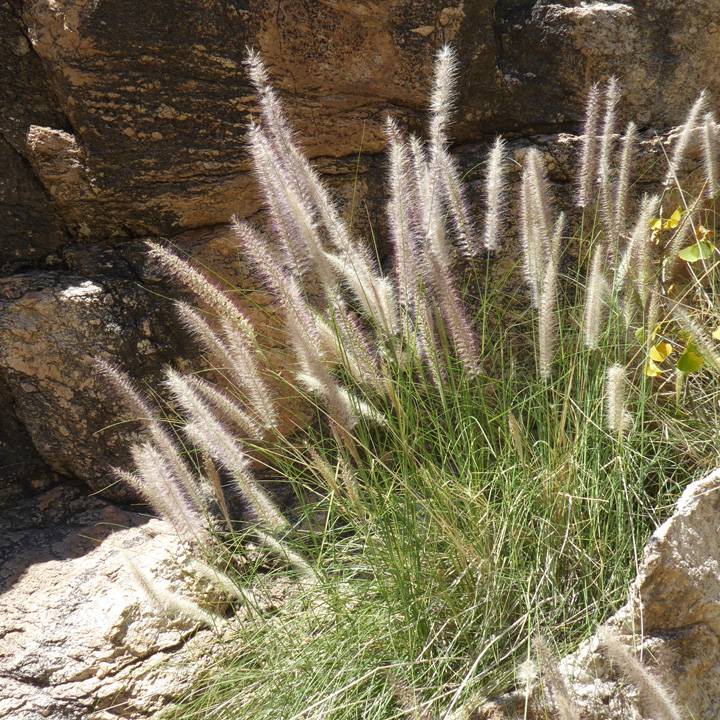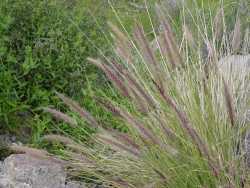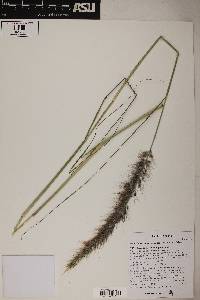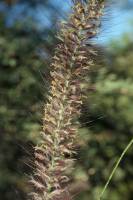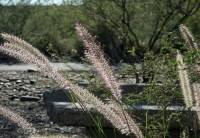|
|
|
|
Family: Poaceae
crimson fountaingrass
[Pennisetum setaceum (Forssk.) Chiov., morePhalaris setacea Forssk.] |
Plants perennial, or annual in temperate climates; cespitose. Culms 40-150 cm, erect, pubescent beneath the panicle; nodes glabrous. Leaves green, sometimes glaucous; sheaths glabrous, margins ciliate; ligules 0.5-1.1 mm; blades 20-65 cm long, 2-3.5 mm wide, convolute or folded, scabrous, midvein noticeably thickened. Panicles (6)8-32 cm long, 40-52 mm wide, erect or arching, pink to dark burgundy; rachises pubescent. Fascicles 8-10 per cm; fascicle axes 2.3-4.5 mm, with 1-4 spikelets; outer bristles 28-65, 0.9-19 mm; inner bristles 8-16, 8-27 mm, ciliate; primary bristles 26.5-34.3 mm, ciliate, noticeably longer than the other bristles. Spikelets 4.5-7 mm, sessile or pedicellate; pedicels to 0.1 mm; lower glumes absent or to 0.3 mm, veinless; upper glumes 1.2-3.6 mm, (0)1-veined; lower florets usually sterile, sometimes staminate; lower lemmas 4-6 mm, 3-veined, acuminate, midvein excurrent to 0.7 mm; lower paleas usually absent, if present, to 4.4 mm; anthers absent or 2.3-2.4 mm; upper lemmas 4.5-6.7 mm, attenuate, 5-veined, midvein excurrent to 0.7 mm, margins glabrous; anthers 2.1-2.7 mm. 2n = 27. Pennisetum setaceum is a desert grass native to the eastern Mediterranean region. It is a popular ornamental throughout the southern United States, but it is also an invasive weed. FNA 2003 Common Name: crimson fountaingrass Duration: Perennial Nativity: Non-Native Lifeform: Graminoid General: Cespitose perennial with erect stems 40-150 cm, pubescent beneath the panicle, with glabrous nodes. Vegetative: Green leaves, sometimes glaucous, glabrous sheaths with ciliate margins; ligules 0.5-1 mm, blades 20-65 cm long, 2-3.5 mm wide, convolute or folded, scabrous, with a noticeably thickened midvein. Inflorescence: Panicle 8-32 cm long, 40-52 mm wide, erect or arching, pink to dark burgundy with a pubescent rachises; spikelets in fascicles 8-10 per cm, axes 2-4.5 mm, with 1-4 spikelets; two sets of bristles, outer 28-65, 1-19 mm long, inner 8-16, 8-27 mm, ciliate; spikelets 4.5-7 mm, sessile or pedicellate, pedicels to 0.1 mm; lower glumes absent or to 0.3 mm, veinless, upper glumes 1-3.5 mm, 1-veined, lower florets usually sterile. Ecology: Found in a variety of habitats throughout the desert regions; flowers spring. Notes: Native to the Mediterranean this was a popular ornamental that has become a problem invasive weed. Easily distinguished by its red and almost plumose panicle. Ethnobotany: Unknown Etymology: Cenchrus is thought to be from Greek kenchros, millet, while setaceus means bristled. Synonyms: Pennisetum setaceum, Pennisetum ruppelii, Phalaris setacea Editor: SBuckley, 2010 |


